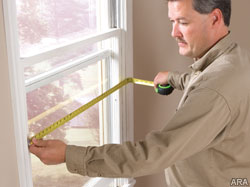(ARA) – Renovating your home can be daunting. The last thing you want to worry about is the possible lead-related health risk of some common renovation tasks. Sanding, demolition and siding and window replacement can all disturb lead-based paint, placing you and your family at risk of lead poisoning.
Because of these risks, the United States Environmental Protection Agency (EPA) developed the Lead-Based Paint Renovation, Repair and Painting Program to help protect homeowners. As of April 22, the legislation requires that workers, including contractors, painters and maintenance personnel, be trained to use lead-safe work practices. Additionally, renovation firms must be EPA-certified.
Because these common remodeling practices can be dangerous to a family’s health, it’s important for you to learn about a contractor’s lead-safe practices before delving into such projects.
“While this legislation does not directly apply to product manufacturers, it has proved to be a challenge for the industry as a whole,” says Rich Black, a replacement channel specialist with Ply Gem, a leading manufacturer of home remodeling and building products. “So manufacturers like Ply Gem have taken a lead on this initiative and are working with customers to organize EPA certification-training programs so that they, in turn, can provide clarification and peace of mind to homeowners.”
What does the legislation entail?
Under the EPA, the legislation:
* Applies to all remodeling/renovation projects on homes, childcare facilities and schools built before 1978 that contain lead paint.
* Is related to on-site work practices.
* Renovation workers must take an eight-hour training course to become certified on lead-safe practices.
Exemptions include:
* Housing built in 1978 or after. If you are not sure what year your home was built and whether or not it contains lead-based paint, it is the contractor’s responsibility to confirm that information.
* Housing for the elderly or disabled, unless a child under the age of 6 lives or is planning to live in the home.
* Homes with no bedrooms, including studio apartments and dormitories.
* Homes declared lead-free by a certified inspector or risk assessor.
* Minor repair work using 6 square feet or less of paint per room inside, or 20 square feet or less of exterior space.
Questions all homeowners should ask
When meeting with a home improvement company or renovation firm, the representative should bring up the issue and provide a government-issued certificate from the EPA showing that their firm has installers who are certified in lead-safe renovation practices. If they do not provide this documentation, homeowners should question if the company is certified.
Also, beware that this legislation may increase the cost of some renovation projects, so homeowners should be careful not to fall for a lower bid from a non-certified contractor.
What the EPA-certification entails
“Before hiring a contractor or renovation firm, it’s important to understand the basics of the legislation and what you should expect from your home improvement company,” says Keith Pigues, chief marketing officer of Ply Gem.
By law, at least one certified installer needs to be on the job site, with a valid certificate, if it was built before 1978 and contains lead-based paint. To become certified, the contractor must attend an eight-hour course that includes education on the dangers of lead-based paint, hands-on learning of safe demolition, installation and disposal of the debris, as well as a final examination. Those who have taken the course can then provide on-the-job training to his or her helpers, who must also be able to provide a certificate to the homeowner.
For more information on the Lead-Based Paint Renovation, Repair and Painting Program, visit www.epa.gov/lead. For more information on renovating your home with Ply Gem products, visit www.plygem.com.
Courtesy of ARAcontent

